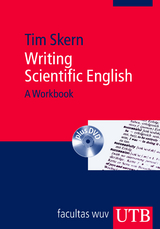Writing Scientific English
UTB (Verlag)
978-3-8252-3619-9 (ISBN)
- Titel erscheint in neuer Auflage
- Artikel merken
Die beiliegende DVD stellt Techniken für mündliche und schriftliche Präsentationen vor und vermittelt die Aussprache wichtiger Begriffe.
Das Verfassen wissenschaftlicher Arbeiten in englischer Sprache ist heute in vielen Studienrichtungen unerlässlich. Gleichzeitig stellt es für Studierende meist eine große Herausforderung dar. Dieses Buch leitet zur richtigen Arbeitsweise und zum korrekten Sprachgebrauch an und schließt damit eine Lücke in der einschlägigen Literatur. Anhand zahlreicher Beispiele werden sowohl gelungene Texte analysiert als auch typische Fehler deutschsprachiger Studierender korrigiert.
Success in science depends nowadays on effective communication in English. This workbook is specifically designed to give under- and post-graduates confidence in writing scientific English. Examples and exercises show how to avoid common errors and how to rephrase and improve scientific texts. The generation of a model manuscript enables the reader to recognise how scientific English is constructed and how to follow the conventions of scientific writing. Guidelines for structuring written work and vocabulary lists will encourage young scientists to develop a concise and mature style. The second edition includes a DVD that discusses and illustrates ideas for improving oral presentations and scientific manuscripts. It also provides the British and American pronunciations of the book’s vocabulary lists.
The workbook is accessible to students of many fields, including those of the natural and technical sciences, medicine, psychology and economics.
Tim Skern, native English speaker, studied biochemistry in Liverpool and London. Now working at the Max F. Perutz Laboratories, he has been teaching scientific English at the University of Vienna and the Medical University of Vienna since 1992.
Chapter 1 11
An introduction to scientific English 11
1.1 Advantages and disadvantages of English 11
1.1.1 British or American? 15
1.2 Formal English, the language of science 17
1.2.1 Complete sentences 17
1.2.2 Punctuation marks 18
1.2.3 Write out all verb forms 21
1.2.4 Avoid starting sentences with "and", "but", "because" or "so" 21
1.2.5 Avoid ending sentences with "too", "also", "though" or "yet" 22
1.2.6 Avoid "get" 23
1.2.7 Avoid vagueness, sensationalism and exaggeration 23
1.2.8 Using "the" and "a" 24
1.3 Words for writing scientific English 27
1.4 Take-home messages from Chapter 130 28
1.5 References 30
1.6 Improvements to exercises 30
Chapter 2 33
Writing clear scientific English 33
2.1 Eight guidelines for improving your writing technique 33
2.1.1 Make a plan 33
2.1.2 Use a clean and legible layout 34
2.1.3 Use paragraphs 35
2.1.4 Write simple sentences 35
2.1.5 Write positive sentences 37
2.1.6 Write active sentences 38
2.1.7 Omit needless words 39
2.1.8 Read and think about your work 40
2.2 Just to make you feel better 41
2.3 Take-home messages from Chapter 2 44
2.4 References 44
2.5 Improvements to exercises 44
Chapter 3 47
Applying the fundamentals 47
3.1 Summarising the text "Fighting for Breath" 47
3.2 Improving four summaries of "Fighting for Breath" 50
3.3 Writing abstracts for scientific presentations 59
3.4 Improving four abstracts 60
3.5 What is science? 65
3.6 Improving four texts on "What is science?" 69
3.7 Take-home messages from Chapter 3 77
3.8 References 78
Chapter 4 79
Constructing a scientific manuscript 79
4.1 The process of publishing original data in a scientific manuscript 79
4.2 Planning a scientific manuscript 84
4.3 Writing a scientific manuscript 90
4.3.1 Prepare the figures and tables 90
4.3.2 Describe the figures and tables 94
4.3.3 Write a first draft of the "results" 95
4.3.4 Write a first draft of the "discussion" 984.3.5 What about writing a combined section entitled "results and discussion"? 100
4.3.6 Write a first draft of the "introduction" 103
4.3.7 Write a first draft of the "title", the "abstract" and the "keywords" 104
4.3.8 Write a first draft of "materials and methods" 107
4.3.9 List and sort the references 109
4.3.10 Write the "acknowledgements" 111
4.3.11 Write the "abbreviations" 111
4.4 Assembling and improving the model manuscript 112
4.4.1 First draft of the model manuscript 114
4.5 Editing and refining a scientific manuscript 119
4.5.1 Improved model manuscript 120
4.6 Take-home messages from Chapter 4 124
4.7 References 125
10 Chapter 5 127
Practising writing and improving scientific manuscripts 127
5.1 Improving the quality of bread 127
5.2 Your views on human activity and global warming 133
5.3 Measuring biodiversity 137
5.4 Stereotypic Man 143
5.5 Searching for the best firewood to reduce global warming 148
5.6 Is there a connection between eating organic food and cigarette smoking? 154
5.7 Take-home messages from Chapter 5 160
5.8 References 161
Chapter 6 163
On your own 163
6.1 Resources 166
6.2 A reading list to improve your vocabulary and your scientific writing 169
6.3 References 177
Chapter 7 179
The scientific vocabulary of this book 179
7.1 Linking words 179
7.2 Words from the basic scientific lexicon 180
7.3 Words that extend the basic scientific lexicon 182
7.4 Words that you wish to add 183
Appendix 191
List of boxes 191
END
| Erscheint lt. Verlag | 26.10.2011 |
|---|---|
| Reihe/Serie | UTB Uni-Taschenbücher |
| Verlagsort | Stuttgart |
| Sprache | englisch |
| Maße | 150 x 215 mm |
| Gewicht | 283 g |
| Themenwelt | Sachbuch/Ratgeber ► Beruf / Finanzen / Recht / Wirtschaft ► Bewerbung / Karriere |
| Schulbuch / Wörterbuch ► Wörterbuch / Fremdsprachen | |
| Naturwissenschaften | |
| Sozialwissenschaften ► Pädagogik | |
| Schlagworte | Anleitung • Arbeitsbuch • Design • Englisch • Englisch; Fachsprache • Englisch schreiben • Fremdsprachen • mündliche Präsentation • Naturwissenschaft • Naturwissenschaften • schriftliche Präsentation • Wissenschaftliche Arbeit • Wissenschaftliches Arbeiten • Writing Scientific English |
| ISBN-10 | 3-8252-3619-6 / 3825236196 |
| ISBN-13 | 978-3-8252-3619-9 / 9783825236199 |
| Zustand | Neuware |
| Haben Sie eine Frage zum Produkt? |
aus dem Bereich





